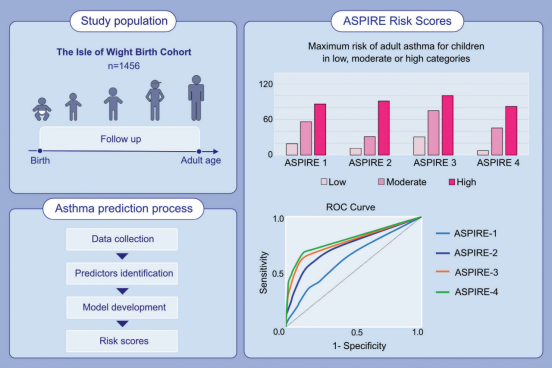Release date:2023-10-25

Allergy
[IF:14.71]
Prediction of adult asthma risk in early childhood using novel adult asthma predictive risk scores
DOI: 10.1111/all.15876
Abstract:
Background:Numerous risk scores have been developed to predict childhood asthma. However, they may not predict asthma beyond childhood. We aim to create childhood risk scores that predict development and persistence of asthma up to young adult life.
Methods:The Isle of Wight Birth Cohort (n = 1456) was prospectively assessed up to 26 years of age. Asthma predictive scores were developed based on factors during the first 4 years, using logistic regression and tested for sensitivity, specificity and area under the curve (AUC) for prediction of asthma at (i) 18 and (ii) 26 years, and persistent asthma (PA) (iii) at 10 and 18 years, and (iv) at 10, 18 and 26 years. Models were internally and externally validated.
Results:Four models were generated for prediction of each asthma outcome. ASthma PredIctive Risk scorE (ASPIRE)-1: a 2-factor model (recurrent wheeze [RW] and positive skin prick test [+SPT] at 4 years) for asthma at 18 years (sensitivity: 0.49, specificity: 0.80, AUC: 0.65). ASPIRE-2: a 3-factor model (RW, +SPT and maternal rhinitis) for asthma at 26 years (sensitivity: 0.60, specificity: 0.79, AUC: 0.73). ASPIRE-3: a 3-factor model (RW, +SPT and eczema at 4 years) for PA-18 (sensitivity: 0.63, specificity: 0.87, AUC: 0.77). ASPIRE-4: a 3-factor model (RW, +SPT at 4 years and recurrent chest infection at 2 years) for PA-26 (sensitivity: 0.68, specificity: 0.87, AUC: 0.80). ASPIRE-1 and ASPIRE-3 scores were replicated externally. Further assessments indicated that ASPIRE-1 can be used in place of ASPIRE-2-4 with same predictive accuracy.
Conclusion:ASPIRE predicts persistent asthma up to young adult life.
First Author:
Abdal J. Farhan
Corresponding author:
Hasan Arshad
Correspondence: S. NIHR Biomedical Research Centre, MP 810, F Level, South Block, Southampton General Hospital, Tremona Road, Southampton, SO16 6YD, UK.
Email: sha@soton.ac.uk
开云电子(中国)官方网站 | 华亿首页(中国)网页版 | 开云网页版 | 天博手机网页(中国)有限公司 | 千亿体育线上平台中国有限公司 | 米兰手机在线登入 | 米乐官方网页版 | 华亿网页版 | 三亿体育首页(中国)网站首页 |
 华亿体育(中国)游戏平台
华亿体育(中国)游戏平台
